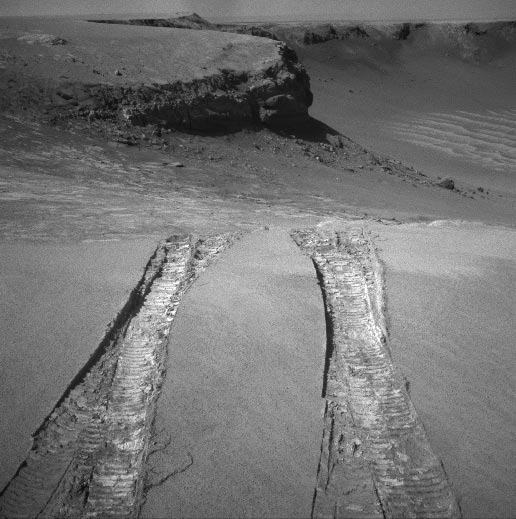Mars Rover Leaves Crater for Martian Plains

Afternearly a year rolling around inside an expansive crater on Mars, NASA?s trustyrover Opportunity is headed back out to explore the Martian plains.
?The roveris back on flat ground,? said Paolo Belluta, engineer and rover driver at NASA?sJet Propulsion Laboratory in Pasadena, Calif.
The golfcart-sized Opportunity climbed up and out of half-mile (800-meter) wide VictoriaCrater on Mars late Thursday with one last 22-foot (6.8-meter) push that sent itcharging over the top of the crater?s rim and through a sand ripple on theother side. The maneuver brought to an end Opportunity?s studies of Victoria,which began in September 2007 when the rover made its first foray into thecrater.
?We?reheaded to the next adventure out on the plains of Meridiani,? said John Callas,NASA?s rover project manager for Opportunity and its robotic twin Spirit on theother side of Mars. ?We safely got into the crater, we completed our explorationthere and we safely got out.?
Opportunityand Spirit have been exploring different parts of Mars since they landed inJanuary 2004. Since then, the rovers have found evidence that water once soakedthe Martian terrain in the ancient past amongtheir other discoveries.
ButVictoria Crater, a deep depression blasted into the Martian surface withexposed bedrock that serves as a window into planet?s geological history, hasdominated Opportunity?s attention. The rover spent more than half of the fouryears since it landed on Mars studying the giant crater.
Opportunityfirst headed for Victoria in late 2004 after visiting a smaller, stadium-sized crater,dubbed Endurance, earlier that year. The rover took 22 months to cross the fewmiles between Endurance and Victoria, and managed to escapea deep sand dune that held it fast for five weeks before engineers wereable to work it back out.
Get the Space.com Newsletter
Breaking space news, the latest updates on rocket launches, skywatching events and more!
Afterarriving at Victoria, Opportunity spent a year meticulously circling partwayaround the crater?s rim to find the best spot to drive into its interior. The roverspent so long at Victoria that NASA?s Mars Reconnaissance Orbiter circling thered planet managed to catch its path around the massive crater.
Opportunity?shandlers decided last month to order the rover to leave Victoria Crater afterspotting a power spike in the automaton?s left front wheel. The roversteadfastly backtracked along its entry path to get back out, mission managerssaid.
?We wereconcerned that any wheel failure on our aging rover could have left us trappedinside the crater,? Callas said.
A similarspike preceded the full-blown failure of wheel on the Spirit rover in 2006. Spiritis currently building a full-color panorama photograph as it awaits bettersunlight conditions for is solar panels at its ?Home Plate? location on Mars,mission managers said.
A thirdNASA spacecraft, the Phoenix Mars Lander, also hit amilestone this week. The stationary probe surpassed its initial 90-daymission earlier this week and began extended operations while digging forburied Martian ice in the planet?s arctic circle.
Sincelanding, Opportunity has spent 1,635 days exploring Mars and traversed morethan 7 miles (11 km) of Martian terrain during its mission.
The roveris now poised to begin hunting new targets: chunks of Mars rocks called cobblesthat lie strewn across the red planet?s surface. Researchers believe thecobbles, which are about the size of a human fist and larger, are chunks ofmaterial ejected from impacts that caused craters that are too far away fromOpportunity to be fully explored.
"Our experience tells us there's lots of diversityamong the cobbles," said rover mission planner Scott McLennan of the StateUniversity of New York, Stony Brook. "We want to get a bettercharacterization of them. A statistical sampling from examining more of themwill be important for understanding the geology of the area."
- Video - Mars Rover Team Ponders Mission's End
- Top 10 Mars Rover Discoveries
- Vote - The Best of the Mars Rovers
Join our Space Forums to keep talking space on the latest missions, night sky and more! And if you have a news tip, correction or comment, let us know at: community@space.com.

Tariq is the Editor-in-Chief of Space.com and joined the team in 2001, first as an intern and staff writer, and later as an editor. He covers human spaceflight, exploration and space science, as well as skywatching and entertainment. He became Space.com's Managing Editor in 2009 and Editor-in-Chief in 2019. Before joining Space.com, Tariq was a staff reporter for The Los Angeles Times covering education and city beats in La Habra, Fullerton and Huntington Beach. In October 2022, Tariq received the Harry Kolcum Award for excellence in space reporting from the National Space Club Florida Committee. He is also an Eagle Scout (yes, he has the Space Exploration merit badge) and went to Space Camp four times as a kid and a fifth time as an adult. He has journalism degrees from the University of Southern California and New York University. You can find Tariq at Space.com and as the co-host to the This Week In Space podcast with space historian Rod Pyle on the TWiT network. To see his latest project, you can follow Tariq on Twitter @tariqjmalik.









